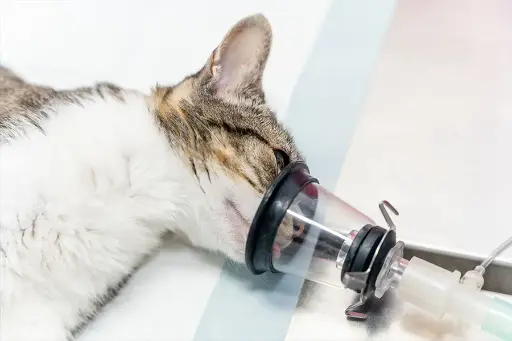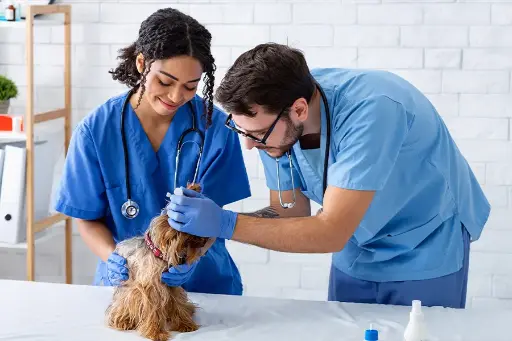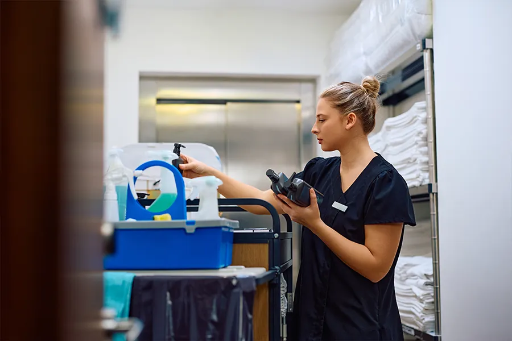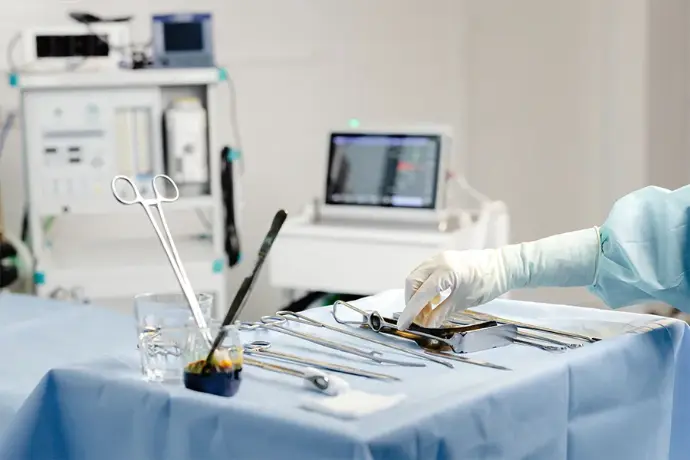As a vet tech, you see the daily challenges of working without certain equipment your friends in other practices may have.
Manual drip calculations, constant line monitoring, and stress all impact your ability to provide the best care. But when you suggest equipment upgrades like veterinary iv pumps or fluid warmers, the conversation often stops at "we can't afford that right now."
What if you could change that conversation by identifying revenue opportunities that would pay for the equipment?In 2025 we completed the AIV-Vet veterinary IV pump survey (which you can download for free here), where we talked with more than 100 vets to understand their experiences with fluid delivery equipment. Our research found that 80% of veterinarians agree that infusion pump upgrades improve patient outcomes - but cost remains the primary barrier.
This guide will help you document and present revenue opportunities that make equipment purchases possible for your manager, positioning you as a valuable strategic partner in practice growth.
Understanding the revenue impact of equipment limitations
Before you can make a compelling case, you need to understand exactly how current equipment limitations affect your practice's revenue (so you can convey that to your manager concisely and confidently). Here are the key areas to investigate.
Referred cases - money walking out the door
Start keeping a log of cases referred to emergency or specialty practices specifically because your clinic lacks equipment or capacity. For each case, note the following:
- The presenting condition.
- The specific equipment needed that you didn't have.
- The specific workload burden at the time.
- The estimated value of the case (ask reception or management for average transaction values).
- Whether the client returned to your practice after referral.
Over 1-3 months, this data will reveal a pattern of lost revenue. Our survey found that 60% of veterinary professionals strongly agree that patient volume spikes create equipment bottlenecks, often necessitating referrals during busy periods.
Declined services - the invisible revenue drain
Track instances where clients decline recommended treatments that would require specialized equipment. Some examples might be…
- Owners who opt for at-home monitoring rather than overnight hospitalization (where there is no clinic-specific benefit presented for overnighting, like iv fluids or body temperature stability).
- Cases where precise fluid therapy would be ideal but is declined due to cost concerns related to the intensive monitoring required.
For each declined service, note what equipment would have made the treatment more accessible or affordable.
Efficiency limitations - the hidden cost
Document how equipment limitations affect practice efficiency.
- Time spent manually calculating and adjusting fluid rates.
- Staff hours dedicated to monitoring critical patients that could be reduced with proper equipment.
- Procedures that take longer due to equipment workarounds.
- Cases requiring additional staff due to monitoring needs that equipment could simplify.
Convert these hours into dollar values using your hourly wage or the practice's average hourly revenue per staff member.
Creating a revenue opportunity report
Once you've gathered data for 3+ months, organize it into a clear report.
Sample revenue opportunity summary (numbers only for illustration)
Revenue category | Monthly potential | Equipment that would capture this revenue | Notes |
Referred cases | $4,200 | 2 CRI pumps, 1 fluid warmer | Based on 6 cases where lack of equipment was the primary reason for referral. |
Declined services | $2,800 | 2 syringe pumps, 1 fluid warmer | Primarily overnight fluid therapy and precise medication delivery for small patients. |
Staff efficiency gains | $1,600 | All proposed equipment | Based on 40 hours/month spent on tasks that could be automated. |
Total monthly opportunity | $8,600 |
Then, create a revenue generation opportunity report to show how easily the upgrades can be funded without an impact to the practice’s current cashflow.
Sample revenue generation opportunity report (numbers only for illustration)
| Service | Current price | Suggested increase | Annual volume | Annual revenue generated |
| Nail trims | $22 | +$3 | 1,000 procedures | $3,000 |
| Anal gland expressions | $25 | +$2 | 800 procedures | $1,600 |
| Routine ear cleanings | $18 | +$2 | 750 procedures | $1,500 |
| Pre-surgical blood work | $95 | +$5 | 500 procedures | $2,500 |
| Fecal tests | $32 | +$3 | 900 tests | $2,700 |
A single $3 increase on nail trims, performed 1,000 times annually, generates $3,000 - enough to purchase more syringe pumps than your plan calls for. Most clients won't bat an eye at this change, yet it directly funds equipment that improves patient care.
Bundling to fund improvements
Another approach is creating service bundles that include a small premium.
- Surgical Comfort Package - adding $10 to surgical procedures to include warmed fluids and automated monitoring
- Senior Wellness Plus - adding $15 to senior visits to include more precise medication administration and monitoring
- Small Pet Precision Package - adding $8 to exotic and small mammal visits to account for specialized equipment needed
The key is connecting these premiums directly to the enhanced care that equipment provides, making the value clear to clients.

Creating a dedicated equipment fund
When presenting these pricing strategies to management, suggest creating a separate accounting category specifically for equipment funding, tracking revenue from these small increases separately, setting target purchase dates based on accumulated funds, sharing progress with the team to maintain momentum.
This approach transforms abstract equipment wishes into concrete funding plans with clear timelines.
Then, create a revenue capture timeline that shows how equipment investments could be phased to capture revenue over time.
Sample revenue capture timeline (numbers only for illustration)
| Year | Equipment investment | Approximate cost | Revenue opportunity captured | Net annual benefit |
| Year 1 | 2 syringe pumps | $1,000 | $33,600 additional | $32,600 |
| Year 2 | 1 fluid warmer | $250 | $16,800 additional | $16,550 |
| Year 3 | 2 more syringe pumps | $1,000 | $19,200 additional | $18,200 |
| Year 4 | 2 advanced CRI pumps | $4,000 | $24,000 additional | $20,000 |
| Year 5 | Additional warmer, replacement parts, repair fund for future repairs | $3,000 | $9,600 additional | $6,600 |
This format clearly shows that each investment captures more revenue than it costs.
Highlighting real-world case examples
Numbers tell part of the story, but specific cases create emotional impact. Include 2-3 detailed examples from your practice in a format that’s short and punch like these examples…
Max the miniature dachshund
Situation: 4-pound dachshund needed precise antibiotic therapy for severe pneumonia.
Current approach: Referred to emergency hospital due to inability to provide care oversight with existing patient load and staffing.
Revenue impact: Lost $1,800 case plus follow-ups.
Equipment solution: Syringe pump ($500) would have allowed existing staff to take on more patient load by removing manual monitoring burden.
Additional benefit: Could have treated 5 similar cases in the past quarter.
Emergency night at full capacity
Situation: Holiday weekend with 4 critical patients needing IV fluids simultaneously.
Current approach: Referred 2 cases due to equipment and staffing limitations.
Revenue impact: Lost approximately $3,200 in revenue.
Equipment solution: 2 additional iv pumps ($1,500) would double capacity with same staffing.
Additional benefit: Would reduce overnight monitoring requirements by 30%
Making the financial case bulletproof
Practice owners need to see that equipment purchases make financial sense. Strengthen your proposal with…
1. A return on investment calculation
For each piece of equipment, calculate the simple ROI:
- Monthly revenue opportunity captured (from your data collection).
- Equipment cost.
- Months to break even (Equipment cost ÷ Monthly revenue).
- Five-year return (Monthly revenue × 60 months - Equipment cost).
Example: Syringe pumps costing $1,000 that contribute to $2,800 in monthly revenue:
- Break-even point is 1.25 months.
- Five-year return is $168,000 ($2,800 × 60 - $1,000).
This demonstrates that equipment is an investment with measurable returns.
2. A cash flow projection
Create a monthly cash flow projection for the first year showing:
- Initial equipment investment.
- Monthly revenue increase.
- Cumulative position.
This shows exactly when the equipment starts generating positive returns, addressing concerns about short-term cash flow impact.
It’s alright if your manager has objections because you have answers
"The numbers look good, but we don't have cash for the initial investment."
Response: "What if we started with just one syringe pump? The data shows we'd recoup that cost in less than 2 months, then we could use that revenue to fund the second pump."
""How do we know clients will actually use these services?"
Response: "I've documented X cases where clients specifically asked if we could provide this care, and Y cases where clients expressed concern about having to go elsewhere."
"We need to focus on marketing, not equipment."
Response: "This equipment actually enables us to market new services. I've identified 3 services our competitors offer that we currently can't because we lack the right equipment."
"We'd need to hire more staff to run this equipment."
Response: "Actually, the data shows we'd save X hours per week in manual monitoring time, potentially allowing us to reallocate staff to other revenue-generating activities."
Presenting your findings effectively
When you're ready to share your analysis, do it at the right time in the right way with the right information organized!
- Schedule a dedicated meeting - not during a busy clinic day.
- Create a one-page executive summary with the key revenue opportunities.
- Start with the biggest revenue opportunity you identified.
- Present the phased approach that begins with the equipment offering the fastest ROI.
- Come prepared with manufacturer information and equipment specifications.
- Offer to be the point person for implementation and training.
Beyond the equipment, this is a smart move for your career
This process of identifying and presenting revenue opportunities does more than just improve your daily work environment.
It demonstrates your understanding of practice finances and business operations.
It positions you as a strategic thinker who sees beyond clinical tasks.
It creates opportunities for leadership roles in equipment management and staff training.
It develops valuable skills in data collection, analysis, and presentation.
It shows initiative that distinguishes you from peers.
We've found that 97% of veterinary professionals experience recurring issues with their current infusion pumps, leading to workflow disruptions and patient care challenges. By championing data-driven equipment planning, you address these frustrations while advancing your career and practice capabilities.

Here’s how to get started this week
Begin building your case with these immediate steps..
- Create a simple tracking sheet for referred cases, declined services, and time-consuming manual processes
- Talk to reception staff about the average transaction values for relevant cases
- Research specific equipment models and current pricing
- Identify one high-value case from the past month that could have been handled in-house with proper equipment
- Schedule a brief conversation with your manager to mention you're gathering data on potential revenue opportunities
You can be an architect in your practice's future
The insights you gather and the case you build for equipment investment are about transforming your practice's capabilities for years. When you approach equipment planning from a revenue perspective, you're more likely to get the tools to make your job easier. But you're also outlining a vision for practice growth.
Think about what your daily work life could look like with the right equipment in place.
More time for direct patient care instead of manual monitoring
The ability to confidently handle complex cases that currently cause stress
Fewer late nights spent worrying about critical patients
Pride in offering the highest standard of care in your community
Recognition as someone who thinks strategically about practice success
The data you collect becomes a powerful foundation for ongoing practice improvements beyond just equipment. You're developing a methodology that can be applied to other practice decisions, from staffing models to new services.
When you take the initiative to connect clinical needs with business opportunities, you become invaluable to your practice in ways that transcend your clinical skills. You demonstrate that you understand the bigger picture of veterinary medicine, where exceptional care and sustainable business practices support each other rather than compete.
Start small, stay persistent, and remember that each piece of data you collect is another piece of the case that will ultimately improve care for your patients, quality of life for your colleagues, and success in your career. The future of your clinic is being shaped by the actions you take today - and your leadership in equipment planning can be a catalyst for positive change that benefits everyone.
Your journey toward better equipment and expanded capabilities begins with the first case you document this week.



